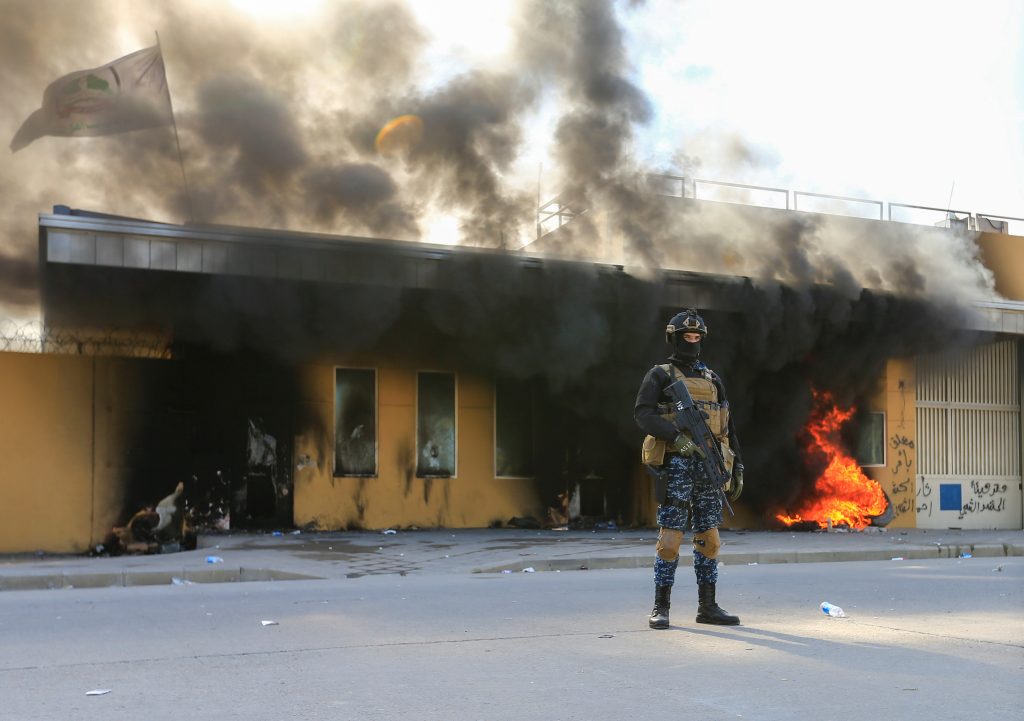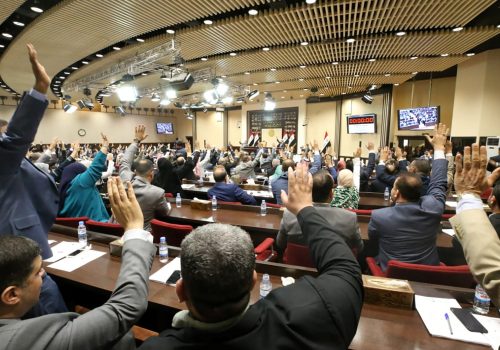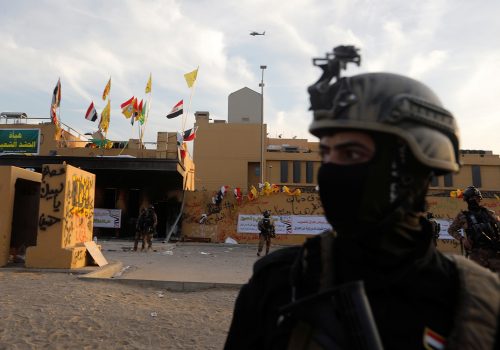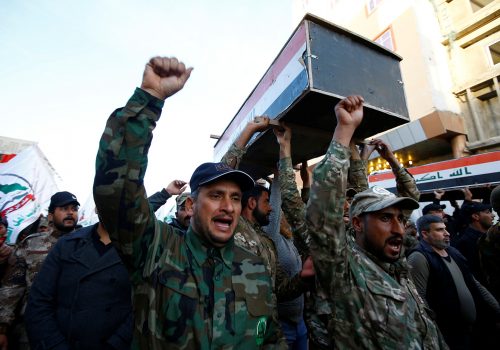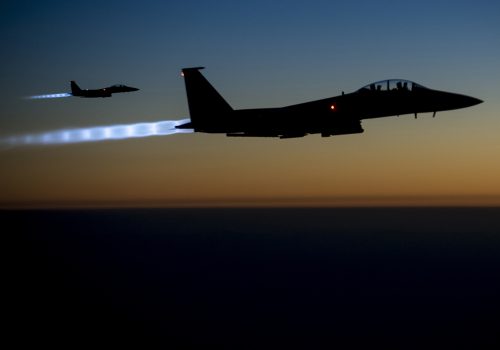Iran, Iraq, and the Trump Administration were on the verge of a history-making crisis when tensions eased after the New Year’s Day withdrawal of Iran’s proxy militias from outside the US Embassy in Baghdad. Iranian-backed militia members went home after an intense campaign of diplomacy with and among Iraqi political actors, and after a Twitter standoff between US President Donald Trump and Iranian Supreme Leader Ali Khamenei.
No one should think this crisis is over. Iran’s stepped-up campaign to drive the United States out of Iraq will continue in other ways.
This most recent escalation was the result of a several-months’ campaign by Kataib Hezbollah (KH) against US forces, culminating in rocket attacks on Friday, December 27, 2019, at an Iraqi base near Kirkuk that killed an American contractor. In retaliation, on Sunday, December 29, the United States struck three KH sites in Iraq, as well as two KH bases in Syria that help move weapons and personnel from Iran through Iraq into Syria. On December 31, KH militia forces and their pro-Iranian allies among the Popular Mobilization Forces (PMF) tried to storm the US Embassy compound.
The danger of war during this crisis is real
One reason this crisis posed a real danger of war is that the United States and Iran look at this crisis differently. United States military and defense experts understand escalation dominance, in which a series of incremental measures are intended to pressure an adversary to change course. Going immediately to all-out war would be seen as unsupportable, so lesser measures are used first until ultimately the adversary desists.
Thus, when KH crossed a red line on December 27 by killing an American, the United States felt it had no choice but to respond with strikes against KH. If Iranian-backed militias had actually gotten into the US embassy and seized Americans, Washington would fear a repeat of the 2012 Benghazi attack that then-Congressman Michael Pompeo (R‑KS) used as a cudgel against then-Secretary of State Hillary Clinton or, worse, a repeat of the 1979 takeover of the US embassy in Tehran that helped defeat US President Jimmy Carter in the 1980 election. The Pentagon would probably have pushed for US military action, first to liberate any hostages and then, once any hostages were freed, the United States would probably have launched strikes against Iranian Islamic Revolutionary Guards Corps (IRGC) forces in Iran itself. Unlike on June 20, President Trump would not call off this strike at the last minute, for fear of looking “terrible” or “dumb,” as Trump claimed previous presidents acted in comparable situations. In all likelihood, Iran and the United States would then have found themselves in a shooting war.
Iran, on the other hand, thinks that since the May 2018 US withdrawal from the nuclear deal it is defending itself against economic warfare waged by the United States, in partnership with Israel and Saudi Arabia, to bring about an end to the Iranian Revolution and Iran’s clerical regime. IRGC Quds Force (IRGC-QF) chief Qasim Soleimani no doubt considers himself a master of asymmetric warfare and the use of proxies whose actions give Iran deniability. Vital to Iran’s security is preventing Iraq from ever being a threat, as Iraq was during the devastating 1980-1988 Iran-Iraq War. This is one reason why Iran’s IRGC-QF is using the Lebanese model of parallel security forces under Iran’s influence or control, but outside the control of the internationally recognized and democratically elected Iraqi government.
Put this way, it is obvious that the US model of escalation in Iraq will not deter Iran from any of its strategic goals, including ending US military and political power in Iraq. The most likely outcome of the New Year’s withdrawal by KH is that Iran will pursue the same goals using different means. Let’s look at four of Iran’s more likely options.
Iran could continue to pressure the United States to close its embassy
US Secretary of State Pompeo was responsible for the September 2018 decision to pull US diplomats out of Basra, southern Iraq’s largest city, and for recent efforts to permanently reduce the number of US personnel in the Baghdad Embassy under the mistaken idea that this would reduce the risk to remaining US personnel. In fact, these actions have emboldened Iran and KH to think that the United States can be forced into a humiliating withdrawal from what was, at one time, the largest US embassy in the world. Expect Iranian efforts to continue.
“…these actions have emboldened Iran and KH…”
Forcing the US embassy to close would not mean the end of US influence in Iraq, if the US military stayed in its bases outside of Baghdad and diplomats relocated to Iraqi Kurdistan. It would, however, considerably diminish US influence, as happened when the United States closed its embassy in Sanaa, Yemen in 2015. It would also be seen as a humiliating defeat for the Trump Administration and would make the forced departure of the US military much more likely.
The United States needs a strategy for maintaining a diplomatic presence in Iraq even in the face of what Iran is doing. A repeat of Trump’s decision to withdraw from northeastern Syria would be hard to paint as anything other than a retreat under fire and would make the world far more dangerous for American diplomats and businesses overseas. Even more than President Trump wants to show his base he is staying out of Middle East conflicts, he does not want pictures of helicopters on the roof as in 1975 Saigon or American diplomats in blindfolds with tied hands as in 1979 Tehran.
The Iraqi parliament is the next arena of US-Iran conflict
The United States has been clear since the occupation ended in 2004 that its continued military presence in Iraq is based on a request from the democratically elected Iraqi government. Since 2014, the United States has also justified its military presence in Iraq as necessary to defeat the so-called Islamic State (ISIS) and to keep ISIS from re-emerging—which ISIS is now doing. But in the context of US-Iran relations, US reliance on the consent of the Iraqi government creates a strategic “vulnerability” that Iran has toyed with in the past—and is now likely to pursue with greater effort: getting the Iraqi Council of Representatives (COR) to adopt a law that would compel US forces to leave Iraq.
As with Lebanon, Iran’s proxies in Iraq are well-represented in the Iraqi parliament, but they do not control it. Iran may have cynically used KH to provoke the United States into attacking KH on Iraqi soil, which would (and did) kill some KH members, but also could increase the number of Iraqi parliamentarians who will vote to expel US forces.
This now makes the Speaker of the Iraqi parliament, Mohamed al-Halbousi, one of the most important parliamentarians in all the Middle East. He has substantial authority to determine whether and under what conditions there would be debate or a floor vote on any parliamentary effort to expel US forces. Iraqi Prime Minister Adil Abdul-Mahdi, now in a caretaker role, may no longer be able to prevent Iranian-backed parliamentarians from introducing a measure that would compel US forces to leave. Al-Halbousi, the former governor of western Iraq’s Anbar province and a Sunni, is strong enough to prevent such a bill from getting to a final vote, especially if he gets support from Iraq’s substantial bloc of Kurdish parliamentarians.
Iran will keep trying to force Iraq to pick a pro-Iranian prime minister
The Iranians are already working on trying to get the Iraqis to select a pro-Iranian, anti-American prime minister who will create conditions that require the Americans to leave. The next prime minister needs to come from a large bloc in the Iraqi parliament—Iraqis are debating what that means—and needs to be nominated by Iraqi President Barham Salih, who represented the Patriotic Union of Kurdistan for many years in the United States. Only one or two Mideast officials know the United States as well as Salih. Salih has rejected three pro-Iranian prime ministerial candidates thus far. He knows that millions of Iraqis, including many who have taken to the streets opposing corruption and Iranian influence, will not accept a prime minister who is in Iran’s pocket.
Iran could seize power in Iraq by extra-constitutional means
Iran and its proxies could, for example, take physical control over the current Iraqi prime minister, stage a coup, or carry out a Tiananmen Square-style massacre of anti-Iranian Iraqi protesters. While many US defense experts are looking at a conventional escalations ladder and off-ramps, IRGC-QF chief Qasim Soleimani has a history of thinking outside of Washington’s idea of the box. Soleimani could see weakness in President Trump’s responses towards Iran and in northeast Syria and could gamble on delivering control of Baghdad into Tehran’s hands.
For example, Iran could decide to force Abdul-Mahdi to remain in office, but place him under house arrest and use Iranian-backed militias to control access to him. Physical control over Abdul-Mahdi could allow the Iranians to pull the plug on Iraqi authorization for a continued US military presence in Iraq.
It is inconceivable that Abdul-Mahdi, who has tried to stay friends with the United States and Iran, would willingly go along with such a plan, but Iran’s Iraqi supporters control the PMF, and they have the power to pull this off, at least initially.
A second option would be a riskier but straightforward Iranian-backed militia coup, in which Kataib Hizballah and other Iranian-backed militias seize control of government institutions, arrest and execute key Iraqi political and military leaders opposed to their power, and force others to flee. Soleimani and his Iraqi proxies would be gambling that President Trump does not have the stomach to order the several thousand US military forces in Iraq to fight against them or to order an invasion to liberate Iraq from Iranian domination.
A third option, probably in conjunction with the second, would use the Iranian-backed PMF units to stage a Tiananmen Square-style massacre of the anti-Iranian protesters in Baghdad’s Tahrir Square. More than 400 Iraqi protesters have already been killed by Iraq’s security services.
There are dozens of ways these options could go wrong for Soleimani or the United States. No one knows what, if anything, the regular Iraqi military would do, nor the marja’iyya religious leadership in Najaf, nor whether the United States military would launch a risky Noncombatant Evacuation Operation (NEO) to extract the thousands of American civilians in central and southern Iraq. But Soleimani may calculate that an Iranian victory that leads to a humiliating US withdrawal and the death or exile of the United States’ remaining Iraqi friends would leave the Islamic Republic of Iran more secure than at any time in Iran’s post-Revolutionary history.
The United States needs to undertake serious planning on how to prevent these “black swan” scenarios from occurring. In more normal times, the best course would be resolute unity and steadfastness from the United States and its Western allies to rein in Iranian adventurism. Unfortunately, for all concerned, these are not normal times.
Thomas S. Warrick is a Nonresident Senior Fellow at the Atlantic Council. He was most recently the Deputy Assistant Secretary for Counterterrorism Policy at the US Department of Homeland Security and a career member of the Senior Executive Service.
Related Content
Image: A member of Iraqi security forces stands near burning tyres at the reception room of the U.S. Embassy, during a protest to condemn air strikes on bases belonging to Hashd al-Shaabi (paramilitary forces), in Baghdad, Iraq January 1, 2020. REUTERS/Thaier al-Sudani
